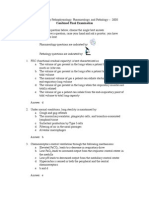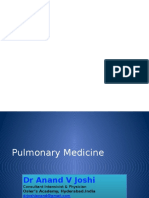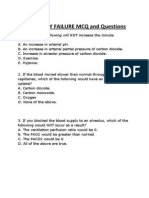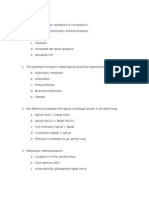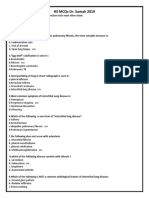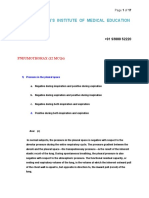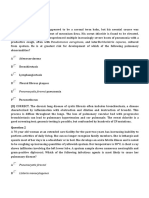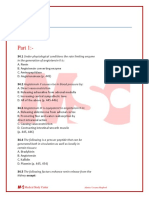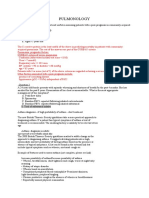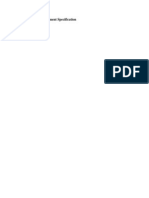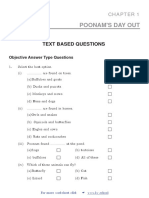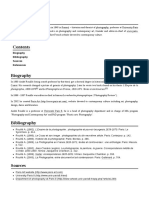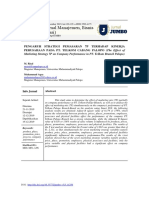MCQ Respiratory
MCQ Respiratory
Uploaded by
anaphysioforyouCopyright:
Available Formats
MCQ Respiratory
MCQ Respiratory
Uploaded by
anaphysioforyouOriginal Description:
Copyright
Available Formats
Share this document
Did you find this document useful?
Is this content inappropriate?
Copyright:
Available Formats
MCQ Respiratory
MCQ Respiratory
Uploaded by
anaphysioforyouCopyright:
Available Formats
Respiratory MCQs
1
A homeless alcoholic presents to your emergency department complaining
of cough, rigors, pleuritic chest pain, and difficulty breathing. Chest
radiograph shows a right upper-lobe pneumonia. What organism must be
considered?
A Klebsiella pneumoniae
B Escherichia coli
C Haemophilus influenzae
D Pneumococcus
Answer
2
Which of the following pulmonary infections is MOST commonly associated
with rust coloured sputum?
A Klebsiella
B Staphylococcus
C Group A streptococcus
D Pneumococcus
Answer
3
Which of the following organisms is resistant to antibiotics that act on the cell
wall?
A Streptococcus pneumoniae
B Klebsiella pneumoniae
C Mycoplasma pneumoniae
D Pseudomonas
Answer
4
A foreign body lodged in the distal one third of the airway can cause all of
the following EXCEPT
A recurrent pneumonia
B inspiratory wheezing
C air trapping on the affected side
D elevation of the affected diaphragm on decubitus film
Answer
5
All of the following are true concerning lung abscesses EXCEPT
A lung abscesses are usually polymicrobial with 60% containing anaerobes
B mortality is 10%
C penicillin G or clindamycin are acceptable treatments
D outpatient management with oral antibiotics is acceptable in non-
immunocompromised patients
Answer
6
Which is the earliest sign of pulmonary oedema on chest radiograph?
A Alveolar oedema
B Upper lobe diversion of vessels
C Interstitial oedema
D Kerley B lines
Answer
7
Which is FALSE in regard to spontaneous pneumothorax
A most common in men between 2040 years of age
B If tension is present, the trachea is deviated to the side of the collapsed lung
C women can have recurrent spontaneous pneumothorax during menses
D smokers are at increased risk
Answer
8
Which of the following is MOST helpful in the diagnosis of a tension
pneumothorax?
A Chest radiograph showing mediastinal shift
B Tracheal deviation toward the affected side
C Bradycardia
D Distended neck veins
Answer
9
Which of the following is MOST correct with respect to massive
haemoptysis?
A Greater than 200 ml in 24 hours
B Patient should be placed in reverse Trendelenburg
C Controlled hypotension should be induced to prevent further bleeding
D Patient should lie with bleeding side down
Answer
10
What is the MOST common organism that causes a parapneumonic
effusion?
A Staphylococcus aureus
B Legionella
C Streptococcus pneumoniae
D Haemophilus influenzae
Answer
11
Which of the following is true regarding pulmonary aspiration?
A Broad spectrum antibiotics are indicated
B Steroid therapy should begin at once to decrease acid destruction
C All patients should be immediately intubated and suctioned
D Bronchodilators are useful to treat bronchospasm
Answer
12
Which features best characterises Pneumocystis carinii pneumonia (PCP)?
A It is readily isolated and cultured in affected individuals
B It usually presents as lobar pneumonia
C It is a bacterial infection that responds well to intravenous sulfa-trimethoprim
D Tuberculosis and atypical mycobacterium infection must be ruled out if PCP
is suspected
Answer
13
Pneumonia due to an unusual or atypical organism should be considered in
patients with all of the following conditions EXCEPT
A uraemia
B splenectomy
C steroid treatment
D hyperthyroidism
Answer
14
All of the following are true concerning Mycoplasma pneumonia EXCEPT
A radiographic findings often appear worse than the clinical picture
B it is most common in adolescents and young adults
C complications are unusual
D a positive serum cold agglutinin test is diagnostic
Answer
15
Which of the following radiographic findings on chest radiograph is least
likely to be seen in active tuberculosis?
A cavitation
B diffuse, patchy infiltrates
C pleural effusion
D cardiomegaly
Answer
16
All of the following statements concerning acute respiratory distress
syndrome (ARDS) are true EXCEPT
A it appears histologically and radiographically as pulmonary oedema
B most instances are associated with other disorders
C mechanical ventilatory support is necessary in most cases
D pulmonary capillary wedge pressure is elevated
Answer
17
All of the following are true regarding high-altitude pulmonary oedema
(HAPE) EXCEPT
A it is the leading cause of death related to high altitude
B it may occur at altitudes as low as 5000 ft above sea level
C a previous episode is a risk factor for recurrent HAPE
D pulmonary capillary wedge pressure is not elevated
Answer
18
The primary treatment for HAPE is
A 100% O2 by nonrebreather mask
B oral acetazolamide, 200 mg, 4 times per day
C oral nifedipine, 1020 mg, 3 times per day
D immediate descent
Answer
19
Which of the following statements is true?
A 6 litres of oxygen via a Hudson mask administers approximate FiO2 of 65%
B A PaO2 of 60mmHg equates to an oxygen saturation of 80%
C Ventilation is likely indicated when measured tidal volume is l< 5 ml/kg
D When estimating pneumothorax size on CXR, an average interpleural
distance ( AID) of 2 cm is equivalent to a pneumothorax size of 16 %
Answer
20
The Mantoux Test may be recorded as positive when
A 4mm induration in HIV +ve patients
B > 10 mm erythema only
C read between 24 and 48 hours
D > 10mm induration, with no previous BCG vaccination
Answer
21
Regarding medication in the treatment of asthma, which one is FALSE?
A Methylxanthines potentiate the effect of Adenosine
B Cromolyn causes a decrease of mast cell degranulation
C Theophylline has a low Volume of Distribution
D Rapid Theophylline withdrawal can cause bronchoconstriction
22
Which of the following is CORRECT?
A Strep. Pneumoniae is responsible for 50% of pneumonias
B Psittacosis is associated with epistaxis in 25% of cases
C Macrolides are treatment of choice for Psittacosis
D ARDS is associated with pulmonary oedema and CCF
Answer
23
With regard to pneumonia which of the following is INCORRECT?
A S. pneumoniae is the agent most frequently associated with death.
B Pleuritic chest pain is associated with increased mortality.
C Legionella pneumophilia is not associated with person to person
transmission.
D Staph. Aureus pneumonia is associated with cavitating lesions.
Answer
24
Which of the following is FALSE regarding COPD?
A PaCO2 > 50mmHg in Type II respiratory failure.
B COPD is diagnosed with FEV1 < 80%.
C Long term prophylactic antibiotics are recommended in severe COPD.
D Long term oxygen therapy reduces mortality.
Answer
25
Regarding a spontaneous pneumothorax, which statement is FALSE?
A Lateral decubitus CXR is as sensitive as CT chest for diagnosis of PTX
B Inspiration and expiration CXRs markedly increase the sensitivity of plain
films in the detection of small PTX
C The likelihood of re-expansion pulmonary oedema increases with the length
of time a lung has been collapsed
D A visible rim of 2cm on an erect adult CXR roughly corresponds to 50% PTX
Answer
26
Regarding acute asthma in adults, which is FALSE?
A A tapering short course of oral steroids is better at preventing relapse than
a short course stopped abruptly
B Spirometry is the most reliable measure of response to treatment
C FEV
1
< 50% predicted indicates severe acute asthma
D In life-threatening asthma, Adrenaline IV is preferred over IM
Answer
27
Regarding NIV used alone in acute asthma, which is FALSE?
A Reduces airway resistance
B Improves gas exchange
C Bronchodilatation
D Counter atelectasis
Answer
28
Regarding asthma management, which is TRUE?
A Oxygen doesnt reverse bronchoconstriction
B Meta-analysis supports the use of IV beta2 agonists in acute severe asthma
C Addition of anticholinergic offers a modest but statistically significant
improvement in lung function
D Steroids dont reduce admission rates
Answer
29
With regards to respiratory function tests, which of the following is TRUE?
A An increased FEV1/FVC ratio indicates a restrictive pattern
B Total lung capacity = vital capacity + tidal volume
C Restrictive lung disease has a high VC
D Peak expiratory flow rate in severe asthma is anything less than 60% of
predicted.
Answer
30
The principles of mechanical ventilation in severe asthma include all of the
following EXCEPT,
A Permissive hypercarbia
B Shorter exhalation times
C Paralysis often required.
D May need the addition of an inhalational agent for further bronchodilatation
31
Alcoholic diabetic patients are at most risk of the following infectious agents,
EXCEPT for
A Burkholderia pseudomallei.
B Klebsiella pneumonia
C Staph aureus
D Mycoplasma pneumoniae
32
Regarding the management of Croup
A Ribavirin is indicated in the hospitalised patient
B 10% of hospitalised children require intubation
C Adenovirus is a cause of croup
D The dose of nebulised adrenaline in a 1 yr old is 5ml 1/1000
Answer
33
In assessing a child with breathing difficulties, which is TRUE?
A The WHO uses a cut-off respiratory rate of 60 in infants and young children
for pneumonia
B Intercostal recession is more easily seen in children older than 6 because
their lungs are less compliant than younger infants
C Stridor is a low pitched inspiratory noise that suggesting poor airway
positioning or pharyngeal obstruction
D All children who have respiratory compromise will have increased work of
breathing
Answer
34
Which is FALSE regarding asthma in kids?
A IV aminophylline has a role in children with severe asthma
B IV magnesium has a proven benefit in children with severe asthma
C There is evidence to support heliox in children with severe asthma
D A single dose of oral steroid has the same efficacy as a 3 or 5 day course
Answer
35
With regard to the differential diagnosis in croup which of the following is
FALSE?
A A congenital airway or vascular abnormality should be considered if the child
is very young and has a history of low-grade stridor
B Toxic or trauma should be enquired of
C Dysphagia and drooling may suggest epiglottitis, retropharyngeal abscess or
inhaled foreign body
D The child with bacterial tracheitis requires no investigations as the diagnosis
is a clinical one
Answer
36
With regard to the management of bronchiolitis which of the following is
FALSE?
A Children with an oxygen saturation of less than 94% need admission
B Children alert, feeding >50% of normal and older than 6 weeks may be
considered for outpatient management
C Steroids are of marginal benefit
D CPAP has no role
Answer
37
Which is NOT a risk factor for death from Asthma?
A 2 or more hospitalisations from asthma in the past year
B Use of >2MDI short acting corticosteroid canisters per month
C Difficulty perceiving asthma severity
D Hospitalisation or an ED visit for asthma in the past month
Answer
38
Regarding Pleural Effusions which is NOT an Exudative cause?
A Mesothelioma
B Rheumatoid arthritis
C Pulmonary Infarction
D Myxoedema
Answer
39
Regarding Pneumothorax
A Women have higher incidence of primary spontaneous
B Traumatic pneumothorax occurs in 15-20% of patients sustaining blunt chest
trauma
C Expiration chest films significantly increase detection of clinically relevant
pneumothorax
D Recurrence after first primary or secondary pneumothorax is 30%
Answer
40
In regard to Community acquired Pneumonia
A
The presence of SIRS in community acquired pneumonia is highly
predictive of death, severe sepsis or shock
B
PSI is more useful at distinguishing which patients require ICU treatment
than other scoring systems
C
Non-invasive ventilation prior to intubation is associated with better outcome
D
Combination of a macrolide with amoxicillin has always been shown to be
effective against Drug Resistant Strep Pneumonia (DRSP)
Answer
41
Which statement regarding COPD is INCORRECT
A Cessation of smoking and home oxygen reduces mortality
B A 10 day course of Prednisolone requires gradual tapering due to adrenal
suppression
C BIPAP improves short term survival
D Aminophylline improved diaphragmatic contractility
Answer
42
Which statement regarding pleural effusions is CORRECT
A Lymphoma is the most common malignancy causing a pleural effusion
B CCF more commonly causes a left sided effusion
C PE more commonly produces a transudate
D A lateral decubitus CXR is more sensitive at detecting effusions than AP or
PA CXR
Answer
43
With regard to resolution of pneumonia, which statement is TRUE?
A Improvement clinically should occur within 12-24hrs of treatment
commencing
B Symptomatic improvement lags behind radiological improvement
C Mycoplasma takes 8-12 weeks to resolve and often causes scarring and
fibrosis
D Legionella takes 12-20 weeks to resolve
Answer
44
Which feature does NOT form a part of the Wells Score for predicting the
probability of PE?
A HR>100
B Haemoptysis
C Age>50
D Malignancy
Answer
45
In pharyngitis due to infection with beta-haemolytic streptococcus group A,
treatment with the appropriate antibiotics reduces the incidence of all of the
following complications EXCEPT:
A Post-streptococcal glomerulonephritis
B Acute rheumatic fever
C Peritonsillar abscess
D Otitis media
Answer
46
Which one of the following statements regarding community-acquired
pneumonia in the adult is TRUE:
A 1 gram amoxycillin 8 hourly orally is often sufficient to treat Streptococcus
pneumoniae that is classed as high-level resistant to penicillin based on
culture and sensitivity studies
B Haemophilus influenzae is the most common cause
C Mycoplasma pneumoniae causes pneumonia mainly in the elderly
D Pneumonia caused by Legionella is relatively more common in the elderly
Answer
47
Regarding non cardiogenic pulmonary oedema, which of the following is
FALSE
A Opiate overdose is not one of the causes
B When measured. Pulmonary capillary wedge pressure is < 18 mmHg
C PCP and salicylates can both cause it
D Can be precipitated at high altitude
Answer
48
Regarding Mycoplasma pneumonia
A It has a 3 day incubation period
B It is the least common atypical pneumonia
C CXR usually shows only minor changes in an unwell patient
D Associated with meningitis and encephalitis
Answer
Answers
1. A
2. D
3. C
4. D
5. D
6. B
7. B
8. D
9. D
10. C
11. D
12. D
13. D
14. D
15. D
16. D
17. B
18. D
19. C
20. D
21. A
22. C
23. B Cameron p278
24. C COPDX Guidelines 2003
25. B BTS guidelines for the management of spontaneous pneumothorax. Thorax 2003;
58(Suppl II):ii39-ii52.
26. A Asthma Management Handbook 2006. National Asthma Council Australia
27. B Cameron page 27
28. C Dunn(asthma management)
29. A B TLC = VC + RV. D < 40%. E this is expiratory reserve volume
30. B Long expiratory times 1:4 IE to allow complete emptying of lungs.
31. D
32. C
33. A APLS manual 4
th
edition
34. B APLS manual 4
th
edition
35. D Textbook of paediatric emergency medicine p159
36. D Textbook of paediatric emergency medicine p156
37. B Rosens Chapter 71 pg893
38. D Rosens Chapter 75 pg 944
39. B Cameron et al, (3
rd
ed) Ch 6.6
40. D Cameron e al (3
rd
ed) p 286-292
41. B Dunn pages 782-785
42. D Dunn p808-809
43. D Dunn, p 787
44. C Dunn, p794
45. A Textbook of Adult Emergency Medicine (Cameron et al., 3
rd
ed.), p. 277
46. A Textbook of Adult Emergency Medicine (Cameron et al., 3
rd
ed.) pp. 283-284
47. A Drugs that can cause it: MOPS! meprobamate, opiate OD, PCP, Salicylate
48. D 14 day incubation, most common, CXR usually worse than the patient, assoc with
bullous myringitis, erythema multiforme, Guillain Barre as well
You might also like
- Test Bank For Respiratory Disease A Case Study Approach To Patient Care 3rd Edition by WilkinsDocument10 pagesTest Bank For Respiratory Disease A Case Study Approach To Patient Care 3rd Edition by Wilkinsa498226706No ratings yet
- 062 Pathology MCQ Respiratory SystemDocument4 pages062 Pathology MCQ Respiratory Systemمجتبى علي100% (19)
- Respiratory MCQsDocument80 pagesRespiratory MCQsAhmad AlSwais80% (5)
- CVS MCQ 2010 PDFDocument23 pagesCVS MCQ 2010 PDFjuniorebinda60% (5)
- Pulmonology MCQsDocument49 pagesPulmonology MCQsaliakbar178100% (1)
- Pulm 2005 Exam QuestionsDocument32 pagesPulm 2005 Exam QuestionsItharshan IndreswaranNo ratings yet
- Respiratory MCQsDocument80 pagesRespiratory MCQsteenup9183% (12)
- Respiratory Physiology AnswersDocument4 pagesRespiratory Physiology AnswersRamya100% (3)
- Respiratory Medicine 1 50Document33 pagesRespiratory Medicine 1 50Ahmed Kh. Abu WardaNo ratings yet
- CVS MCQsDocument14 pagesCVS MCQsThana AlAnsari100% (3)
- Pulmon Ology MCQ SDocument280 pagesPulmon Ology MCQ SSai Shanker100% (1)
- MBBS Pathology MCQsDocument4 pagesMBBS Pathology MCQsDoctorAlan John Naveen Chandar100% (2)
- Respiratory Failure MCQ and QuestionsDocument5 pagesRespiratory Failure MCQ and QuestionsChikezie Onwukwe60% (5)
- Consumers, Producers, and The Efficiency of Markets: Multiple ChoiceDocument11 pagesConsumers, Producers, and The Efficiency of Markets: Multiple Choiceboywonder1990No ratings yet
- Respiratory MCQs LJDocument7 pagesRespiratory MCQs LJfjghNo ratings yet
- 6 - Resp MCQs - SGDocument17 pages6 - Resp MCQs - SGOsman Somi100% (1)
- RespiratoryDocument57 pagesRespiratoryMuhammad Javed GabaNo ratings yet
- Internal Medicine 1Document23 pagesInternal Medicine 1Asif Newaz100% (1)
- MCQs PulmonologyDocument2 pagesMCQs PulmonologySadia Batool86% (7)
- Lung MCQDocument7 pagesLung MCQArvinth Guna Segaran100% (3)
- Respiratory MCQDocument10 pagesRespiratory MCQSyeda Aroosa Abbas Naqvi100% (1)
- MCQ RespiratoryDocument6 pagesMCQ Respiratorynurulhudaabdulmuiez100% (2)
- Pneumology 2018Document16 pagesPneumology 2018Kris100% (1)
- Respiratory Medicine 151 200Document31 pagesRespiratory Medicine 151 200Ahmed Kh. Abu Warda100% (2)
- Respiratory MCQDocument3 pagesRespiratory MCQMarjina Khatoon NipuNo ratings yet
- Wiki Resp Mcqs ExplainedDocument7 pagesWiki Resp Mcqs ExplainedArvinth Guna SegaranNo ratings yet
- Path Lung McqsDocument24 pagesPath Lung McqsShafaque Irfan100% (1)
- MCQ-Chronic Obstructive Pulmonary DiseaseDocument3 pagesMCQ-Chronic Obstructive Pulmonary DiseaseMittulNo ratings yet
- RS MCQsDocument2 pagesRS MCQsraed faisalNo ratings yet
- Pulmonology: The Cells of The Bronchial Epithelium, LeucocytesDocument64 pagesPulmonology: The Cells of The Bronchial Epithelium, LeucocytesSk Chaudhry100% (1)
- 8th Finals McqsDocument28 pages8th Finals McqsMuhammad Uzair GujjarNo ratings yet
- MCQ RespiratoryDocument6 pagesMCQ Respiratoryalemante100% (2)
- Mcqs RespirationDocument2 pagesMcqs Respirationbushra100% (4)
- MCQs and Cases 5th YearDocument118 pagesMCQs and Cases 5th Yearyoune6No ratings yet
- Pleural MCQS MedicineDocument17 pagesPleural MCQS MedicineCheryls Raju100% (1)
- PulmonaryDocument27 pagesPulmonaryRitz CelsoNo ratings yet
- GIT MCQs DR - Ahmed MowafyDocument15 pagesGIT MCQs DR - Ahmed Mowafya7wfNo ratings yet
- CVS MCQsDocument21 pagesCVS MCQsMohammed Boyka100% (1)
- Candidates Mcqs Pathology Week 11: 1 JF A BDocument3 pagesCandidates Mcqs Pathology Week 11: 1 JF A Bمجتبى علي0% (1)
- Respiratory System Study GuideDocument13 pagesRespiratory System Study GuidebisnumNo ratings yet
- Pathology - Cardiovascular SystemDocument17 pagesPathology - Cardiovascular SystemNdegwa Jesse100% (2)
- ANS QuestionsDocument5 pagesANS Questionsparanoea911No ratings yet
- MCQS With KEY - PAEDSDocument7 pagesMCQS With KEY - PAEDSSiraj Ul IslamNo ratings yet
- MJCQDocument94 pagesMJCQElsayed Ahmed0% (1)
- Cardiovascular MCQs LJDocument11 pagesCardiovascular MCQs LJYanis Yan100% (1)
- MCQs On CVS Pharmacology by Medical Study CenterDocument47 pagesMCQs On CVS Pharmacology by Medical Study CenterLin YunNo ratings yet
- Chronic Obstructive Pulm DiseaseDocument8 pagesChronic Obstructive Pulm DiseaseLouis FortunatoNo ratings yet
- Respiration MCQs (2016), Dr. Ahmad AlarabiDocument7 pagesRespiration MCQs (2016), Dr. Ahmad AlarabiTofik Mohammed100% (1)
- Pathology MBBS MCQsDocument7 pagesPathology MBBS MCQsShahzad Asghar Arain100% (4)
- 003 Pathology MCQ ACEM Primary CardiovascularDocument5 pages003 Pathology MCQ ACEM Primary Cardiovascularbmhsh100% (2)
- Thoracic MCQsDocument11 pagesThoracic MCQsMarwa Al-AzzawiNo ratings yet
- MCQ PancreasDocument1 pageMCQ Pancreassekhar100% (1)
- Pulmonology LastDocument82 pagesPulmonology LastAbdallah K. Ramadan100% (1)
- Pathology Mcqs Week 11: 1. in Adult Respiratory Distress SyndromeDocument4 pagesPathology Mcqs Week 11: 1. in Adult Respiratory Distress Syndromeمجتبى علي100% (6)
- Pulmonary TB MCQSDocument4 pagesPulmonary TB MCQSAbid SunhanNo ratings yet
- Pathology McqsDocument40 pagesPathology Mcqspkpowerhouse100% (1)
- MCQ Infectious DiseasesDocument14 pagesMCQ Infectious Diseasespathfind007No ratings yet
- Engineering Recommendation Letter ExampleDocument11 pagesEngineering Recommendation Letter ExampleMohamedsaidNo ratings yet
- Foaming Capacity of SoapDocument10 pagesFoaming Capacity of SoapAnonymous D5g37JjpGBNo ratings yet
- 2011 Prelim YearlyDocument23 pages2011 Prelim YearlyAndrewHannaNo ratings yet
- Problems Encountered, Coping Mechanism and Behavioral Changes of Selected Internally Displaced Meranaw High School StudentsDocument7 pagesProblems Encountered, Coping Mechanism and Behavioral Changes of Selected Internally Displaced Meranaw High School StudentsMC FototanaNo ratings yet
- Law AssignmentDocument4 pagesLaw AssignmentKarishma AhmedNo ratings yet
- 2.1 System Requirement SpecificationDocument30 pages2.1 System Requirement SpecificationAtif NiazNo ratings yet
- Introduction To Business-to-Business (B2B) Marketing/Industrial MarketingDocument14 pagesIntroduction To Business-to-Business (B2B) Marketing/Industrial MarketingNjuguna ReubenNo ratings yet
- Annabel Lee NewDocument23 pagesAnnabel Lee NewTrà My MaiNo ratings yet
- B1 Bcce Test Hau Book 2Document18 pagesB1 Bcce Test Hau Book 2elceffieNo ratings yet
- Literary GenresDocument56 pagesLiterary GenresOtencianoNo ratings yet
- Int Endodontic J - 2022 - Clauder - Present Status and Future Directions Managing PerforationsDocument20 pagesInt Endodontic J - 2022 - Clauder - Present Status and Future Directions Managing Perforationsjorge2412No ratings yet
- Practice-Markowitz SolvedDocument10 pagesPractice-Markowitz SolvedSagar KansalNo ratings yet
- Gudmundstoddir Shulman 1987Document14 pagesGudmundstoddir Shulman 1987pedroNo ratings yet
- Choice WordsDocument3 pagesChoice Wordsapi-111745026No ratings yet
- BIO Central Tendency Distributions and SpreadDocument30 pagesBIO Central Tendency Distributions and SpreadAhmed AhmedNo ratings yet
- AGRICULTURE6 W9 D1 PortraitDocument2 pagesAGRICULTURE6 W9 D1 PortraitRonnie SumicadNo ratings yet
- Dell EMC Partner Training GuideDocument23 pagesDell EMC Partner Training Guidejamssuper0% (1)
- Data Migration StrategiesDocument6 pagesData Migration StrategiesypraviNo ratings yet
- The Cambodian Genocide and Imperial CultureDocument8 pagesThe Cambodian Genocide and Imperial CultureJonathan Robert Kraus (OutofMudProductions)No ratings yet
- Ncceevpb 01Document10 pagesNcceevpb 01GomathiSubramanianNo ratings yet
- Duration of Anticoagulation After Cerebral Venous Sinus Thrombosis 2012 Neurocritical CareDocument8 pagesDuration of Anticoagulation After Cerebral Venous Sinus Thrombosis 2012 Neurocritical Caremorris_tyoNo ratings yet
- Case Digest Nolasco Vs PanoDocument1 pageCase Digest Nolasco Vs PanoRalph Veloso100% (1)
- Claiming Orion - Bell K MDocument166 pagesClaiming Orion - Bell K Mkkusumjo97No ratings yet
- André RouilléDocument2 pagesAndré RouilléFernando Maia da CunhaNo ratings yet
- THE OUTSIDERS Full TextDocument55 pagesTHE OUTSIDERS Full Textdiego.fdobregonNo ratings yet
- Progress Report Term 1 AY 2023-2024Document4 pagesProgress Report Term 1 AY 2023-2024PonytailNo ratings yet
- CHAPTER 1 Research Cmate LycaDocument8 pagesCHAPTER 1 Research Cmate LycalycaebuengaNo ratings yet
- JUMBO (Jurnal Manajemen, Bisnis Dan Organisasi)Document10 pagesJUMBO (Jurnal Manajemen, Bisnis Dan Organisasi)Jack D'Ripper100% (1)
- Homeroom Guidance Program Quarter 1-Module 1 Value Self: School Senior HighDocument10 pagesHomeroom Guidance Program Quarter 1-Module 1 Value Self: School Senior Highchristine pelenioNo ratings yet





